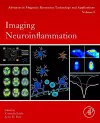
Imaging Neuroinflammation
2 authors - Paperback
£131.00
Nivedita Agarwal is a board-certified neurologist and neuroradiologist currently working at the Hospital of Rovereto, Azienda Provinciale per i Servizi Sanitari in Trento, Italy. She is appointed adjunct assistant professor at the Department of Radiology, subsection of Neuroradiology of the University of Utah in 2010 and annually fulfills her responsibilities by teaching to residents and fellows in radiology and neuroradiology. She serves as the medical director for Functional Neuroimaging Laboratory at the University of Trento. Over the past six years she has diversified her teaching experiences in the areas of Radiology, Cognitive Neuroscience and Mathematics at the universities of Verona, Trento, Utah and at Johns Hopkins. Her signature lectures include combining neuroanatomy with function, and she has organized several seminars in this field over the past 5 years. Her research includes the development of diffusion tensor and resting state functional imaging techniques and their applications to individual patients (so-called Precision Medicine). She is the author of several scientific articles in peer-reviewed journals and has been an invited speaker at national and international scientific meetings.
John D. Port, M.D., Ph.D. received his BS in computer engineering from the Massachusetts Institute of Technology in 1986. He received his Ph.D. in Neuroanatomy from the University of Illinois in Chicago in 1992, and his M.D. from the University of Illinois College of Medicine in 1994. He completed his medical residency and fellowship in Radiology and Neuroradiology, respectively, at the Johns Hopkins Hospital in 2000. He is currently an Associate Professor of Radiology as well as an Assistant Professor of Psychiatry at Mayo Clinic in Rochester Minnesota. He is a board certified radiologist and neuroradiologist, and spends the majority of his time in clinical practice. His research primarily involves developing magnetic resonance (MR) spectroscopy and MR imaging tools for various clinical applications including psychiatric, metabolic, and endocrinology diseases. To date he has written over 50 peer-reviewed publications, 5 book chapters, and over 100 abstracts that were presented at national and international meetings. He is well known internationally for his research and educational presentations on psychiatric illness, specifically schizophrenia and mood disorders.